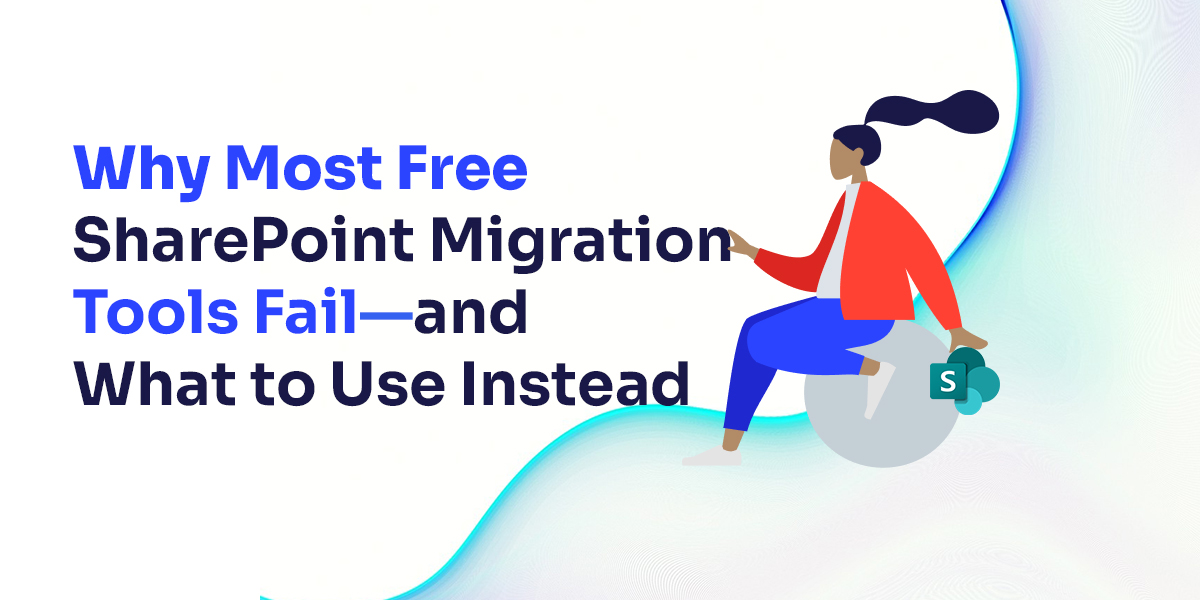Why Most Free SharePoint Migration Tools Fail—and What to Use Instead

Content management platforms like SharePoint are getting immense recognition for smooth collaboration and data access. SharePoint migration is a complicated task and requires a lot of consideration for successful execution.
A SharePoint migration tool is the foundation of error-free migration of data between two SharePoint sites or tenants. However, if you pick the wrong one, the complete process can turn out into a big disaster, resulting in potential data loss. With so many options in the market, businesses often turn to free tools to migrate SharePoint data.
This article explains some major reasons why most free tools for SharePoint migration fail to deliver the expected results. Furthermore, it also sheds light on what to consider for a hassle-free migration. But first let’s see why do you need to perform SharePoint migration.
Why migrate to SharePoint? (Common reasons)
Here are some reasons why it’s important to migrate data to SharePoint:
- Store data within a centralized platform providing users with access to everything they need.
- Provides higher security to the organization’s data protecting it from cyberthreats and breaches.
- Allows organizations to scale and adapt to evolving business requirements.
- Regulates better communication between team members through video calling and other messaging tools.
- Better workflow with apps like OneDrive, Teams, Planner, etc.
Pitfalls of free SharePoint migration tools: Why do they fail?
When there are lot of choices to choose from, free SharePoint Online migration tool seems to be the easiest choice. Even though free tools like SharePoint Migration Tool (SPMT) are quite helpful, there are certain risks and limitations associated. Let’s have a look at those one-by-one:
Less sources supported
Open-source tools like SPMT migrate SharePoint sites to an extent. It simplifies migration from on-premises SharePoint, such as SharePoint 2019, 2016, 2013, and earlier to on-premises and SharePoint Online. Performing tenant to tenant SharePoint migration can be difficult in the case of freeware.
Such solutions fail to give support to third-party platforms, such as Dropbox, Google Drive, Amazon S3, etc.
Limited amount of data is migrated
Migrating with the free tools allows migration of data with limitations. You cannot rely on such solutions to perform bulk data migration. Using these to migrate multiple data items can lead to slow performance and delays in the planned migrations. This will eventually impact the overall business efficiency.
Permission and metadata migration
It is quite complicated to handle migration of permissions and metadata using the free migration solutions. Some of the custom metadata, such as created & modified dates and created & modified by aren't supported by the freeware solutions.
There might be complications during the transfer of complex permissions and permission inheritance. In such case, you might need to manually fix the issue to avoid allowing access to unintended users.
Slow migration speed
There are multiple factors affecting migration speed, such as network bandwidth and server performance. Large scale migration using a free SharePoint migration solution like SPMT can take a lot of time.
It is impossible to run multiple migration jobs simultaneously using this tool, which can cause slow performance issues.
Complex user interface
The user-interface of free migration software is not as friendly as paid solutions to all the users. Non-technical users may face issues at navigating throughout the tool.
Lack of automation and reporting features
Just like manual methods, several free migration tools for SharePoint do not offer automation of migration processes. You cannot rely on free tools to Schedule migration jobs for later. There’s a need to run processes manually.
Moreover, freeware never promises to provide the migration report at the end of the process completion.
Incremental/delta migration is not supported
With no incremental or delta pass migration support in manual migration tools, there is a possibility of data duplicity within the SharePoint sites. This can cause issues with data management over the SharePoint tenant.
Selective migration of data
There’s no flexibility of choosing specific data when you’re migrating SharePoint sites using free migration solutions. You have to perform transfer of all the data within the SharePoint server.
Data Integrity and Security Risks with Free SharePoint migration tools
Even though you can use free tools to migrate SharePoint site contents, there is a risk of losing crucial business data. Free solutions never guarantee the accuracy, integrity, and security of data. SharePoint migration performed under poor environment host errors and inconsistency.
There are chances of cyber attackers getting into your confidential data. Incorrect user mapping during the migration can create loopholes that attackers use to breach the security. Most migration tools that provide a free version do not support data encryption methods. Furthermore, there are lesser feature and security updates introduced in such tools.
Expect limited support with free SharePoint migration software
Have you ever thought what would you do if the migration process stuck before completion? What would you do if there’re are discrepancies in the migrated data? What if the new environment is showing compatibility issues?
Feeling overwhelmed seeing these questions is completely fine but ignoring them is not. Most free SharePoint Online migration tools do not provide any extended support if any error or inconsistency is encountered due to migration. To overcome this, you’ll either need to find a solution that provides post-migration assistance or use a third-party licensed SharePoint tool for migration.
What to Use Instead: Get Professional solutions
Rather than running after the free solutions, the best approach to migrate the SharePoint data safely would be third-party tools. There are several professional tools available in the market that you can consider. Here are some benefits that you can look for in the professional software:
Quicker migration
Professional tools to migrate SharePoint site helps to perform quicker migration of contents. You can use it to migrate all data, including sites, lists, libraries, workflows, versions, permissions, etc.
Easy bulk migration of site contents
With a professional tool, it’s easy to migrate multiple SharePoint sites in one go. You’ll not need to migrate each site or subsite manually. This will speed up the migration process especially when there is a huge amount of data to be migrated.
Support multiple sources and destinations
A professional migration tool for SharePoint will support multiple sources and destinations. It will not just migrate data between two SharePoint sites, rather you can use it to migrate data from multiple sources to SharePoint or vice versa.
Migrate permissions and metadata
Getting professional tools helps to smoothly migrate user permissions with the inheritance and access level. They allow easy user mapping and preserve metadata, which is significant for effective data migration.
Offer free trial version
The enhanced advantage of third-party solutions is that they come with a free trial version. It allows you the power to go through the tool’s functionality and perform migration for a certain set of data before buying it.
Provide migration summary and logs
After the completion of migration processes, these tools provide detailed migration summary and migration logs. You can use the reports for reference to analyze the process. This will help you prepare for more successful migrations in future.
Allows selective migration
They help you perform a selective migration with the help of the advanced filters integrated within the tool. These tools provide filters, such as date range, item type, and others to make it easy for you to migrate specific items.
Maintain hierarchy and integrity
With these tools, you can perform data transfer without altering the hierarchy or integrity of data. All the documents, files, folders, etc. will remain the same after moving to the destination as they originally were.
How to pick a suitable SharePoint migration tool?
Now that you know what’s the best solution to migrate SharePoint site data, it’s crucial to learn how to select a reliable SharePoint migration tool. Here’s a checklist that will help you out.
Conduct thorough planning
Start with a thorough plan and list out everything that you want in a migration tool. Note down the scope and objectives of the migration. Sort out the data in the source environment and see what amount of data you actually need to migrate. See if the tool supports bulk migration of data.
Verify the compatibility offered
Check for the compatibility between the source and target environments. Additionally, you can check what are the sources and destinations supported by the tool. It will be great if you can find that support migration between multiple platforms.
Check out all the features
See what the features are supported by the tool. You can look for the following features:
- Pre-migration analysis
- Backup of SharePoint sites
- On-premises to on-premises SharePoint
- On-premises to SharePoint Online
- SharePoint Online to SharePoint Online migration
- Secured methods to login SharePoint sites
- Track real-time progress of the process
- Bulk migration
- Run automated migrations with scheduler
Verify if these features are supported by the tool.
Check if customization is supported
Analyze the tool and see if it allows customization for the SharePoint environment. Verify if it is possible to create custom workflows with the tool.
Run pilot migration
It’s always better to run a test batch of data for migration before transferring all the data. Running pilot migrations helps to see if there’s any possibility of encountering errors during the actual process. This will help you test the capacity of the tool you’re planning to proceed with.
Perform data validation
Remember to establish that the tool maintains integrity and hierarchy throughout the migration. Identifying this at an early stage helps confirm whether the tool is appropriate or if you need something else.
Allows post-migration maintenance
The migration process doesn’t finish with data transfer. Even after migrating the data, you need to take care of a lot. You need to stay in touch with the end users and stakeholders to see if there are any complications in accessing the new environment.
To avoid issues, check which SharePoint migration tool allows post-migration support. This will provide you with a scope of improvement for your destination environment and enhance productivity.
Tips to avoid errors during SharePoint migration
Here are some tips that you can follow to avoid inconvenience:
- Take proper time to learn about the source and destination environment.
- Inform end users and stakeholders about the change.
- Train your users before time to avoid complications.
- Make sure to inventory your sites and test for upgrade.
- Not mapping the users and their permissions correctly.
- Ignoring migration of metadata along with the site content.
- Take regular data backups to avoid losing data.
Which SharePoint migration tool is suggested?
There are so many solutions to migrate SharePoint content and getting overwhelmed with that is completely natural. However, you need to decide which one of them matches your requirements to the closest.
One of the effective and trustworthy solutions that matches the suggested checklist is Kernel Migration for SharePoint. The tool supports migration of everything, including sites, lists, libraries, files, metadata, workflows, web parts, etc. It supports a user-friendly interface that simplifies migration for all users, whether technical or non-technical. Let’s see what the major features are it allows access to:
- Migrate data between any SharePoint version (on-premises and online).
- Migrate data from file server to SharePoint site.
- Transfer data between Google Drive and OneDrive storage.
- Support easy pre-migration analysis of data.
- Take data from cloud storage (AWS, Box, and Dropbox) to SharePoint.
- Allows bulk migration of data in one go with a pre-mapped CSV.
- Migrate multiple SharePoint sites at once.
- Run selective migration of data preserving version history.
Conclusion
Following this article thoroughly will help you avoid failures during the migration process. It’s crucial to understand that free SharePoint solutions to migrate sites can be tempting, but it can mean potential data loss. Therefore, do your research and choose wisely to avoid severe repercussions when transferring the data.
To save your time looking for an efficient tool, we suggest Kernel Migration for SharePoint. It supports taking comprehensive and selective migration of data to a SharePoint tenant.
Hyperlink InfoSystem - Most Trusted End-to-End development Solution Provider.
Write For Us





